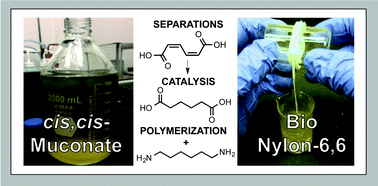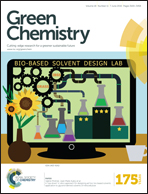cis,cis-Muconic acid: separation and catalysis to bio-adipic acid for nylon-6,6 polymerization†
Abstract
cis,cis-Muconic acid is a polyunsaturated dicarboxylic acid that can be produced renewably via the biological conversion of sugars and lignin-derived aromatic compounds. Subsequently, muconic acid can be catalytically converted to adipic acid – the most commercially significant dicarboxylic acid manufactured from petroleum. Nylon-6,6 is the major industrial application for adipic acid, consuming 85% of market demand; however, high purity adipic acid (99.8%) is required for polymer synthesis. As such, process technologies are needed to effectively separate and catalytically transform biologically derived muconic acid to adipic acid in high purity over stable catalytic materials. To that end, this study: (1) demonstrates bioreactor production of muconate at 34.5 g L−1 in an engineered strain of Pseudomonas putida KT2440, (2) examines the staged recovery of muconic acid from culture media, (3) screens platinum group metals (e.g., Pd, Pt, Rh, Ru) for activity and leaching stability on activated carbon (AC) and silica supports, (4) evaluates the time-on-stream performance of Rh/AC in a trickle bed reactor, and (5) demonstrates the polymerization of bio-adipic acid to nylon-6,6. Separation experiments confirmed AC effectively removed broth color compounds, but subsequent pH/temperature shift crystallization resulted in significant levels of Na, P, K, S and N in the crystallized product. Ethanol dissolution of muconic acid precipitated bulk salts, achieving a purity of 99.8%. Batch catalysis screening reactions determined that Rh and Pd were both highly active compared to Pt and Ru, but Pd leached significantly (1–9%) from both AC and silica supports. Testing of Rh/AC in a continuous trickle bed reactor for 100 h confirmed stable performance after 24 h, although organic adsorption resulted in reduced steady-state activity. Lastly, polymerization of bio-adipic acid with hexamethyldiamine produced nylon-6,6 with comparable properties to its petrochemical counterpart, thereby demonstrating a path towards bio-based nylon production via muconic acid.


 Please wait while we load your content...
Please wait while we load your content...